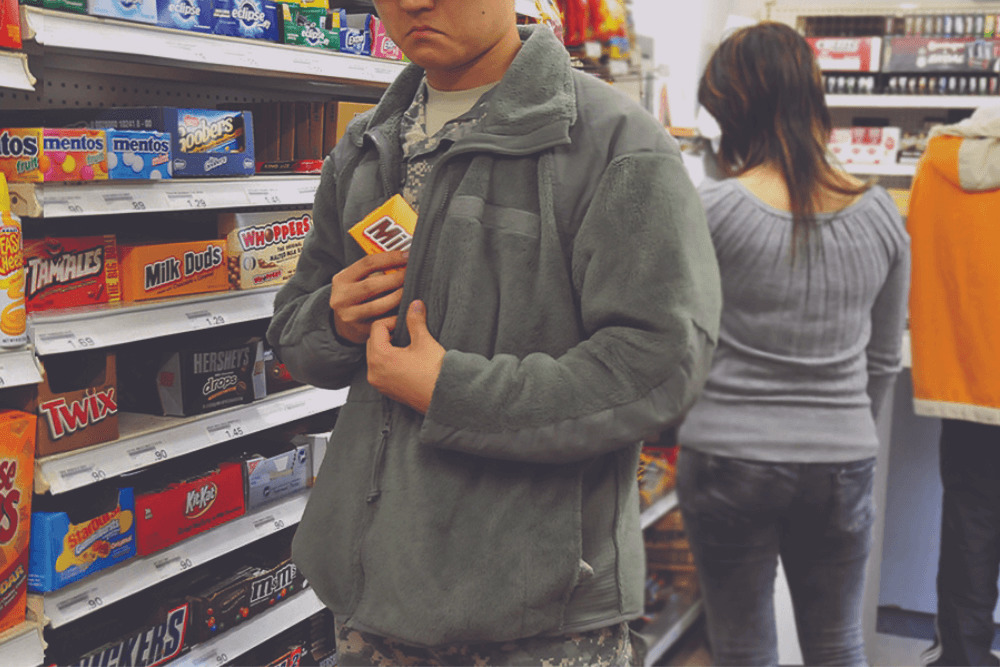Shoplifting Statistics

It’s generally considered a minor offense, but ultimately, shoplifting is still a crime. And it’s one that has a greater impact than people realize. Let’s break down some ins and outs of this common property crime. Who are shoplifters? What are they taking, and from where? These shoplifting statistics reveal all.
Shoplifting Statistics: A Look at the Numbers
According to FBI crime data, there were more than 548,000 shoplifting cases in 2021, nearly 20% of all reported theft/larceny crimes. (The “bright” side? That’s down from the 835,000 shoplifting cases U.S. retailers experienced in 2020.)
And those are only the people that got caught and turned in. In fact, shoplifters say that someone catches them in only one out of every 49 instances of a shoplifting crime. If that’s true, there might be upwards of 26 million shoplifting incidents per year.
But this is just the start. There are plenty of more U.S. shoplifting statistics to dissect.
How Common Is Shoplifting?
Shoplifting is an alarmingly common crime. Approximately 10-11% of the U.S. population has shoplifted at some point. Other researchers indicate that 27 million Americans have committed a shoplifting offense.
If you’re good with numbers, you’ll notice that those figures don’t quite add up, considering the current U.S. population is around 330 million. Many shoplifting facts and statistics are several years old and rely on self-reporting. In other words, there is a lot of room for error. After all, who wants to admit that they’re a shoplifter, even in a survey?
Who Is Shoplifting?
Many people associate shoplifting with the rebellious teen years. This would suggest that perhaps there are more minor shoplifters than there are adults. But in reality, research has shown that adult shoplifters outnumber juveniles 3 to 1. That said, many adult shoplifters confess that their habit began when they were children. Shoplifting can be chronic and even addictive.
A small number of shoplifters are professionals who steal products in order to resell them, ultimately making a living as thieves. Only about 3% of U.S. shoplifters are professionals, but their crimes account for more than 10% of the revenue that retailers lose annually to shoplifting.
Meanwhile, some instances of shoplifting are “inside jobs.” Some employee theft comes in the form of shoplifting. About 75% of retail employees have stolen from their employer at least once, and half of those steal again.
What Gets Taken?
Truly, the items that shoplifters target depend on the type of retailer and the shoplifter’s intentions. There’s a big difference between stealing for personal use and stealing for resale. And in the case of addictive shoplifting behavior, the thief might not even care what the item is or how much it costs.
The glamorized stories that depict shoplifting as something honorable—like taking a loaf of bread to prevent starvation, in the style of Les Miserables or Aladdin—aren’t necessarily accurate in modern-day America. While it’s true that some food staples (meat, cheese, seafood) make the list of the most commonly shoplifted items from grocery stores, there are some less heart-warming entries, like liquor and cosmetics.
What about other retailers? Clothing stores take big hits from the theft of denim jeans, shoes, designer clothing, and handbags. Meanwhile, computer theft is an extremely common target in electronics stores. Be it desktops or laptops, hardware or software, thieves covet computers and their paraphernalia. In recent years, goods related to post-natal childcare like formula and diapers have become hot items.
Organized retail crime (ORC) “professionals” have slightly different targets. According to a 2020 survey by the National Retail Federation, the top stolen items for ORC gangs are designer clothes, laundry detergent, razors, designer handbags, and deodorant. The common denominators? Profitability, portability, and demand.
All of that said, any item that a shoplifter can use or resell at a profit is fair game. Online marketplaces—Facebook, eBay, Craigslist, etc.—have become the perfect outlet for shoplifters to resell items below the MSRP. But even without an internet connection, the enterprising shoplifter still has options. Pawn shops, yard sales, bodegas, check cashing businesses and flea markets are all well-used forums for shoplifted goods and gift cards.
Where Is It Stashed?
With all this merchandise being smuggled out of stores, one might wonder just where the crooks are putting it. There are a few popular methods and hiding spots that shoplifters seem to prefer.
Shopping bags are common, especially bags brought in from a different store. Perhaps less obvious, and certainly more diabolical, is the baby stroller. Shoplifters hide their stolen goods under the materials already in the stroller: blankets, pillows … even their actual babies. Another trick is to carry an umbrella and stash items inside the closed fabric. Skilled shoplifters will also use long coats with the interior lining modified to include extra pockets. Diaper bags, newspapers, large skirts, hats… almost anything can conceal shoplifted goods.
For brazen perpetrators, no receptacle is necessary. It’s increasingly common for thieves to grab items off of a shelf and then simply run out of the store. These shoplifters aren’t concerned about being seen. They simply count on their speed to escape any pursuers. That’s assuming anyone is pursuing them in the first place, which is not necessarily the case.
Why Is It Getting Easier to Shoplift?
Recently, many retailers have instituted policies that specifically prohibit their employees from attempting to deter or physically interfere with shoplifters. In the National Retail Federation’s 2022 survey, 37.9% of participating retailers don’t allow employees of any kind to apprehend shoplifters. The potential liability if the employee is harmed is more of a risk than the lost revenue.
While many employees no doubt appreciate being in a safe workplace, the tradeoff has (in some cases) been an upward trend in shoplifting cases. Perpetrators are increasingly aware that no one is going to chase after them. That said, that same survey indicated that many retailers plan to compensate for the lack of employee intervention by investing in sophisticated loss-prevention technology like RFID systems and AI analytics tools.
When Do People Shoplift?
Winter is the favorite season for the American shoplifter. Some reports indicate that about half of retailers’ annual loss due to shoplifting occurs during the winter, with 81% of those incidents happening in the weeks leading up to the holiday season.
Wednesday through Saturday, the busiest shopping days, are also the busiest days for stealing. If you think about it from a thief’s perspective, it’s easier to get away with shoplifting when you’re surrounded by a crowd.
Where Does Shoplifting Happen the Most?
It may come as no surprise that some of the busiest cities in America are also the biggest hotbeds of shoplifting activity. Bustling, high-traffic locations make the perfect place to commit retail theft because there are more crowds into which to slip and disappear unnoticed. The National Retail Federation’s list of cities with the most organized retail crime contains no surprises, as they’re among America’s most populated:
- Los Angeles, CA
- Oakland, CA
- New York, NY
- Houston, TX
- Miami, FL
- Chicago, IL
- Sacramento, CA
- Seattle, WA
- Atlanta, GA
- Dallas/Fort Worth, TX
There’s no strict rhyme or reason to which stores get hit, but research from ASU indicates that affected stores tend to be in city centers, near highways, near schools, or in low-income areas. Stores are more vulnerable if they’re understaffed, have lots of exits, or lack clear sightlines.
How Much Are Retailers Losing?
Calculating retail theft loss statistics is an inexact science. In part, this is because many actions contribute to retail shrinkage beyond shoplifting. Example: A cashier inadvertently ringing up a customer incorrectly is counted as shrinkage. It’s obviously not the same as shoplifting, but it can be hard to categorize shrinkage incidents appropriately into shoplifting vs. accident vs. damage in post facto inventory audits.
In its most recent Annual Retail Theft Survey, Hayes International estimated that retailers lose $15-20 billion each year to shoplifters. The average loss in 2021 was $1,178.57 per incident, an increase of 26.6% from 2020. Retailers recover only a tiny fraction of these losses.
How to Stop Shoplifters
Knowing more about shoplifting statistics is great, but if you run a retail business, how do you stop customers from shoplifting? There are plenty of strategies and tools you can combine to make your store less of a target.
Policies, Procedures, and Business Practices
How you run your business can play a role in preventing theft. Perform a background check on all new hires. Ensure that the retail floor is sufficiently staffed at all times so that there’s always someone to watch shoppers. Hiring security guards can be a major theft deterrent if your budget allows it. Encourage your employees to personally greet all customers and ask if they need assistance. Monitor dressing rooms. If you sell big-ticket items like electronics, consider posting an employee at the exit to validate receipts.
Keep the store tidy so it’s obvious when products go missing. And, of course, perform regular inventory checks to account for those missing items.
Store Design
Your store’s layout may help or hinder shoplifters. Your main goal is to make shoppers feel like they’re in plain sight. That might mean lower shelves and displays, convex mirrors, bright lighting, wide aisles, minimal exit paths, or checkout areas near the front door. If a shoplifter knows someone is watching, they’ll be less inclined to pocket items.
Another strategy is to limit customers’ access to products. Keep hot products in a locked case or behind the counter. And for those top-dollar items, keep only a few on the sales floor at any time. You’ll notice if any go missing and the potential total loss is lower.
Loss-Prevention Technology
As mentioned above, many retailers plan to invest in modern loss-prevention tools. The most popular, according to the National Retail Federation:
- RFID systems: 38.6% of surveyed retailers plan to implement
- AI-based POS/SCO video analytics: 29.8%
- License plate recognition: 19.3%
- Self-service locking cases or lockers: 17.5%
- AI-based perimeter surveillance: 14%
- Advanced weapon detection (AI, thermal, etc.): 12.3%
- Facial recognition: 12.3%
- Multi-sensor parking lot or curbside surveillance towers/units: 12.3%
And you can always use tried-and-true devices like security tags.
The Role of Security Cameras
Because of how careful and practiced experienced shoplifters are, retail security cameras may not be enough to catch the theft and prevent them from escaping. It’s not impossible, but it can be tricky. That said, the mere presence of visible security cameras in a store can act as a deterrent, stopping potential shoplifters before they commit a crime. Prevention is always preferable to recovery.
If a determined thief decides to flout the risk and steal, your cameras can help you after the fact. The police can use your surveillance footage to track down the criminal and apprehend them. In the modern age, facial recognition software and social media can lend a helping hand. Post images of the shoplifter on your store’s page, asking the public for their help with identification. Some retailers have found success with this method, leading to a surprising number of successful arrests and convictions.
For advanced after-hours surveillance, consider Deep Sentinel. Live security monitoring means that trained professionals are watching your store the instant the AI-powered business security cameras detect a threat. They can intervene, set off an alarm, and call the cops—all before the perp has time to steal anything.
Need a Solution that Prevents Crime?
Deep Sentinel is the only security technology that delivers the experience of a personal guard on every customer’s home and business. Visit deepsentinel.com/business or call 833-983-6006

